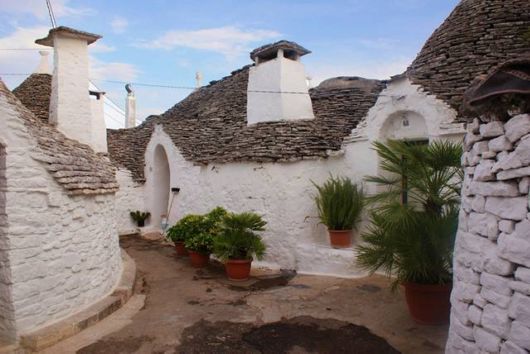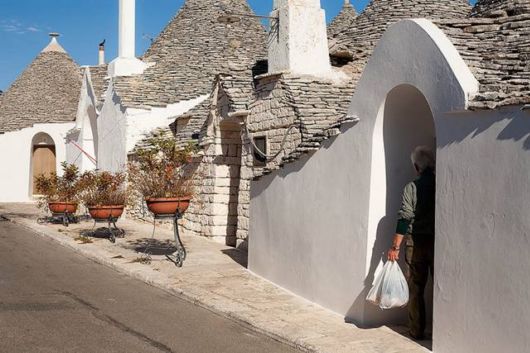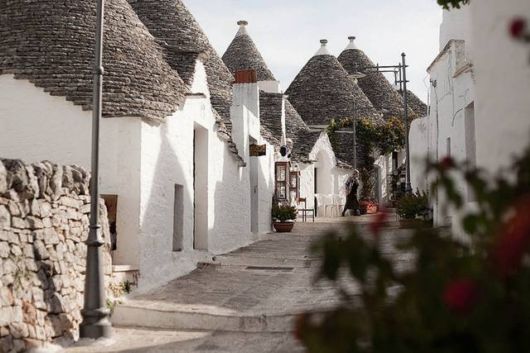Alberobello, the city of drystone dwellings known as trulli , is an exceptional example of vernacular architecture. It is one of the best preserved and most homogeneous urban areas of this type in Europe. Its special features, and the fact that the buildings are still occupied, make it unique. It also represents a remarkable survival of prehistoric building techniques. There was prehistoric settlement in the Itria and the tholos (dome-shaped tomb) tradition of building may have come to the region at this time. The present settlement dates from the mid-14th century, when what appears to have been an uninhabited area was granted to the first Count of Conversano by Robert d’Anjou, Prince of Taranto, in recognition of his service during the Crusades. He and his successors colonized the area by moving people from their other fiefs, allowing them to build cottages known as caselle.

However, recent research suggests that scattered rural settlements that began around AD 1000 gradually coalesced to form the village units of latter-day Aja Piccola and Monti. Tradition has it that drystone walling was imposed upon the new settlers so their houses could be quickly dismantled. This served two purposes: recalcitrant householders could be dispossessed easily and, later, it would be possible to avoid taxation on new settlements. In the latter case the buildings could be reconstructed equally rapidly. This is known to have occurred in 1644 to thwart tax inspectors sent by the King of Naples. However, historical and comparative analysis suggests that this technique was a minimal physical response to local conditions, later to be exploited for punitive purposes.

By the mid-16th century the Monti area was already occupied by some 40 trulli , but it was in 1620 that the settlement began to expand, when Count Gian Girolamo Guercio ordered the construction of a bakery, a mill and an inn. By the end of the 18th century the community numbered over 3,500, and in 1797 they brought the feudal rule of the Acquaviva family to an end by obtaining the status of royal town from Ferdinand IV, King of Naples. The name of Alberobello was adopted, taken from the medieval Latin name of the region, siva arboris belli . From this time onwards the construction of new trulli quickly declined.

These buildings were constructed using roughly worked limestone boulders collected from neighbouring fields and, later, the large water-collecting basins in the area. They were built directly on the underlying natural rock, using exclusively the drystone technique. The walls that form the rectangular rooms are double, with rubble cores, and are pierced by small windows. Fireplaces, ovens and alcoves are recessed into the thickness of the walls. The roofs, which are also double-skinned, spring directly from the walls, simple squinches allowing the transition from the rectangular to the circular or oval sections of the roofs themselves. These are built up of successive courses of grey limestone slabs, known as chianche or chiancarelle . The roofs of the larger building terminate in a decorative pinnacle, often apotropaic in function. There are ingenious provisions for collecting rainwater using projecting eaves at the base of the roof which divert the water through a channelled slab into the cistern beneath the house. Flights of narrow stone steps give access to the roofs.
The interiors are equipped with wooden fittings, such as door frames, barrel-vaulted niches, etc., and in some of the larger trulli there is a second storey formed from a wooden floor and reached by means of a wooden staircase. Stone fireplaces and ovens are ventilated through stone slabs covering them. The roofs are not painted and develop a patina of mosses and lichens; they sometimes bear mythological or religious symbols in white ash. By contrast, the walls of the trulli must be whitewashed at regular intervals, which has the effect of rounding the outlines of the stones, giving a brilliant homogeneous surface. The Monti quarter, which covers 6 ha on a hillside, contains 1,030 trulli . Its streets run downhill and converge at the base of the hill. The Aja Piccola quarter, with 590 trulli , is less homogeneous than Monti. The streets converge on a common farmyard where in feudal times the peasants were forced to thresh wheat.































